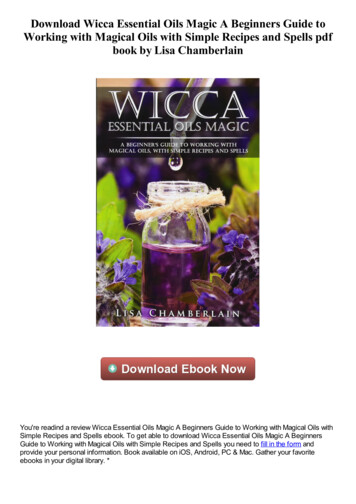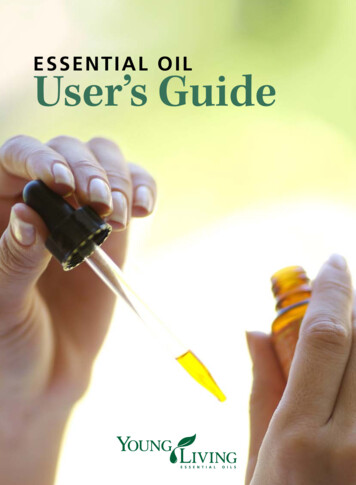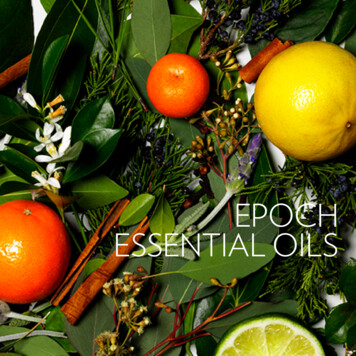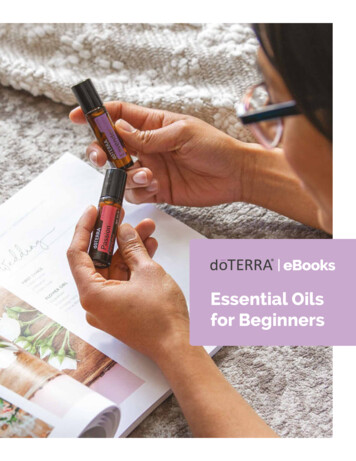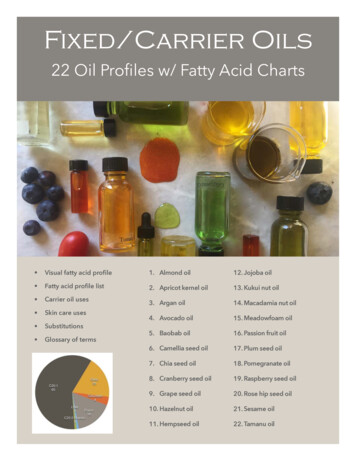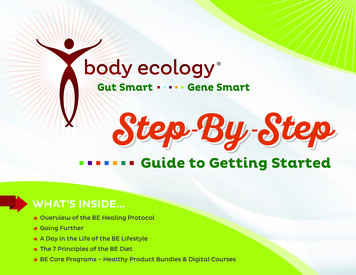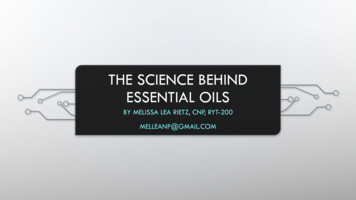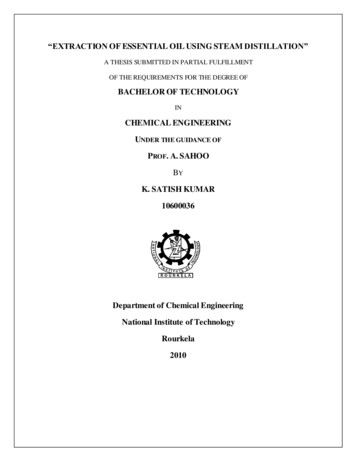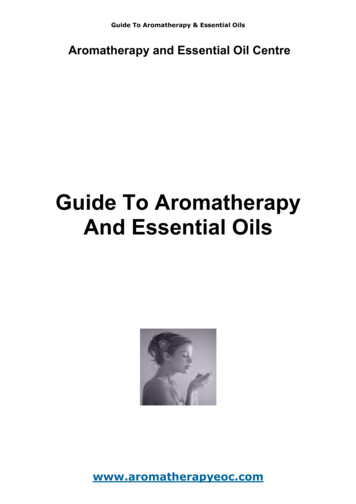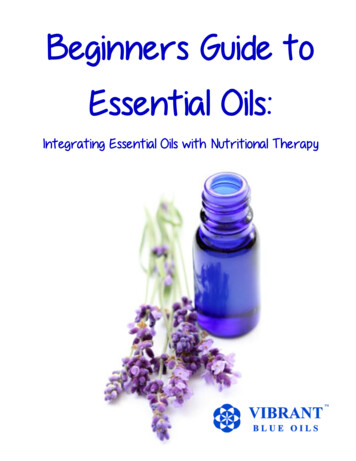
Transcription
Beginners Guide toEssential Oils:Integrating Essential Oils with Nutritional Therapy1
IntroductionEssential oils are the natural, highly concentratedessences extracted from specific shrubs, flowers,grasses, fruits, bushes, seeds, roots, trees for theirhealing capabilities.This shared chemistry makes essential oils one ofthe most compatible of all plant substances withhuman biochemistry. Essential oils are also lipidsoluble with a protein-like structure similar to humancells, making them even more compatible withEssential Oils provide key components of the plants’ human cells and tissues.immune systems. They help the plants grow, thrive,evolve, and adapt to surroundings. For example,Since essential oils are bio-familiar to humans, theythey protect plants from bacterial and viral infections, can also help balance and support the human bodyheal injuries, repel unwanted insects, prevent water to heal itself. Research has shown that essential oilsloss and other environmental damage, play a role in help us fight infection (with anti-bacterial, anti-fungalplant pollination and deliver oxygen and nutrientsand anti-viral properties), balance hormones andinto the cells. This is why they are “essential” for aemotions and aid in regeneration. Essential oils alsoplant -- without them, plants could not survive.help the brain, reviving a tired mind and stimulatingmemory. Different fragrances of essential oils willIn the human body, they play a similar role -relax, revitalize or renew your mind, body and soul.transporting valuable nutrients to the cells,increasing oxygen intake, and digesting toxic waste Highly concentrated essential oils are also extremelypotent. A drop or two can produce significant resultsin the blood. This is because the three primarybecause an entire plant, when distilled, mightelements - carbon, hydrogen and oxygen - areproduce only a single drop of essential oil. They arecommon to both human beings and essential oils.approximately 75-100 times more concentrated, andconsequently far more potent, than dried herbs.2
Essential Oils for Nutritional TherapyVibrant Blue Oils was foundedby nutritional therapy practitioners who observed that certainlifestyle challenges -- sleep issues, constant stress, anxiety,depression and exhaustion -impeded the body’s ability toheal. In our exploration of noninvasive, natural solutions tothose conditions we stumbledupon therapeutic grade essential oils and were overwhelmedby how effectively they alleviated emotional, hormonal, digestive, immune, detoxification andnervous system challenges.Benefits of essential oils for nutritional therapy:Inner Brain Stimulation: The aromafrom essential oils stimulates the olfactory nerves (nerve sensors for smell)which reach the inner brain throughnasal pathways. Nerve fibers run fromthe olfactory membrane into the innerbrain — the hypothalamus — whichcontains the important, self-regulatorycenters that regulate warmth, waking,sleeping, blood pressure, breathing,digestion, elimination and fat and watermetabolism. Most importantly, planthormones from essential oils have anamazing effect human hormones, especially on the functioning of the pituitary gland, the master regulator of allhormones.How Do Essential Oils Work?Essential oils contain manynatural chemical constituentsthat have been documented totherapeutically affect ALL theinner workings of the humanbody. They can calm and sedate the nervous system,effectively reducing stress, anxiety and depression,improving sleep, mood, energy, brain function andstrengthening the body’s immune system and detoxification capabilities.As the essential oils are inhaled or applied topically,they enter the bloodstream quickly and exert measurable effects, including a 21% increase in oxygen levels which helps to effectively transport nutrients to thecells of the body and to increase available cell oxygen. Many types of infectious organisms can live onlyin low-oxygen environments. By increasing cellularoxygen, essential oils may help to create an environment in which pathogenic (disease-causing) bacteria,viruses, fungi and parasites cannot survive.When applied topically, the lipid soluble essential oilmolecules penetrate the fatty layers of the skin intothe blood circulation, creating a profound effect on thewhole body.2. Nervous System: Research revealed that applying essential oils tothe skin can stimulate the nerve endings in the skinwhich connect to the vast inner network of the sympathetic and parasympathetic nervous systems of thebody. By traveling from the skin surface inward to thedeeper body systems, these precious oils can helpbalance the functioning of the nervous system.3. Hormone Activation and Blood Circulation: Research also showed that essential oils, with their planthormones, can be absorbed by the body and functionas hormone precursors that can activate our own hormones. In addition, plant hormones absorbed throughthe skin can enter the blood circulation, improving itand the blood chemistry.Essential oils can serve as a powerful bridge to amplify the success of nutritional protocols and with it,your clients vibrant health.3
Vibrant Blue:Created by Practitioners for PractitionersVibrant Blue Oils is the only essential oil products designedby and for nutritional therapy practitioners. Instead of relying on myth and lore, we are actively assessing our clientsand ensuring that our blends shift the body towards healing.We know that essential oils have a powerful effect on thebody. That means that therapeutic blends have the capacityto help, and potentially stress, the body. This is because essential oils are powerful medicines and like any medicine,they can cause damage when used incorrectly.With this in mind, Vibrant Blue Oils is committed to continually testing, refining and developing new blends for optimalhealing with minimal downside. We are also committed toprovide ongoing nutritional training to support practitionersin their use of essential oils for vibrant health.For example, we have discovered that oils work so effectively that they often are not required for long term use. A blendcan work perfectly for a client for several months, but as theclient’s health continues to shift and improve, the old blendgradually ceases to yield the same beneficial results. Forthis reason, it is important to retest and switch up oils fairlyregularly.Essential Oils BlendsThis understanding drove our decision to market our blendsin 5 ml bottles, which has been known to provide the optimaldosage necessary for a shift. Some clients will see amazingresults from a favorite blend for years, while others will shiftevery few months. The 5 ml bottles provide practitionerswith the optimal ability to shift oils frequently with minimumfinancial hardship to clients.Vibrant Blue Oil blends have been created with the intention of bringing the body into balance so clients can heal. In many ways, blends are more powerful than single oils. Theyare created when several single essential oils have been synergistically combined to create something that is greater than the sum of its parts.The combination yields not only the power of the combined chemical constituents and frequencies, but also the synergy of how they interact together. This means that the respective powers of the individual oils change to enhance their energy. For example, the antiinflammatory effects of chamomile are increased when combined with lavender.Many practitioners report the experience of seeing the client’s body completely shift afterapplying the blends. We are both excited and encouraged by the potential of essential oilblends to dramatically assist in challenging areas of our practices and are committed toongoing research and product development in that area.4
History ofEssential OilsThroughout history, the essential oils of plantswere used in many cultures for their medicinaland therapeutic benefits. The Egyptians wererenown for using essential oils extensively inmedical practice, beauty treatment, food preparation, and in religious ceremony. Frankincense,sandalwood, myrrh and cinnamon were considered very valuable cargo along the ancientcaravan trade routes and were sometimes exchanged for gold.Borrowing from the Egyptians, the Greeksused essential oils in their practices oftherapeutic massage and aromatherapy.The Romans also used essential oils to promotehealth and personal hygiene. Influenced by theGreeks and Romans, as well as Chinese andIndian Ayurvedic use of aromatic herbs, the Persians began to refine distillation methods for extracting essential oils from aromatic plants. Essential oil extracts were used throughout thedark ages in Europe for their anti-bacterial andfragrant properties.More recently, the powerful healing properties ofessential oils were rediscovered in 1937 by aFrench chemist, Rene-Maurice Gattefosse, whoplunged his badly burnt hand into a vat of lavender oil (mistaking it for water) and was surprisedto see no injury or scarring. A French contemporary, Dr. Jean Valnet, used therapeutic-gradeessential oils to successfully treat injured soldiers during World War II. Dr. Valnet went on tobecome a world leader in the development ofaromatherapy practices.With the invention of synthetic drugs, the use ofplants & herbs for their therapeutic propertiestemporarily declined. That trend is reversing ashealth scientists and medical practitioners continue to research and validate the benefits oftherapeutic-grade essential oils to protect thebody, boost the immune system, and revitalizethe mind and influence mood, without the negative side effects commonly associated with synthetic drugs.5
Chemistry of the OilsThe therapeutic benefits of the oil are often relatedto the compound(s) at the highest amount in the oil.In general, essential oils can be subdivided into twodistinct groups of chemical constituents:1. HydrocarbonsMade of terpenes which inhibit the accumulation oftoxins and help discharge existing toxins from theliver and kidneys. Key terpenes include:· Monoterpenes – (Found in Grapefruit, Orange,and Balsam Fir) Inhibit the accumulation of toxins, detoxify kidneys and liver, enhance balance, restore information in DNA.· Sesquiterpenes – (Found in Cedarwood, Sandalwood and Myrrh) Antiseptic, anti-inflammatory,stimulate liver, increase oxygenation around thepineal and pituitary glands, can surpass theblood-brain barrier and enter the brain tissue.The chemical profile of an essential oil determinesits viscosity, volatility and medicinal properties.The molecular structure of essential oils are ringlike and far more complex than the simpler, linearcarbon-hydrogen structure of fattyoils. The essential oil chains areheld together by carbon atoms linkedwith oxygen and hydrogen, along withnitrogen and sulfur atoms (which arenot found in other non-essential plantoils).2. Oxygenated compounds· Alcohols (found in Ravensara, Rosewood, Geranium) – Uplifting, high resistance to oxidation,antiseptic, antiviral, revert cells to normal function.· Aldehydes (found in Cinnamon Bark,Lemongrass) - Calming, relieve stress andblood pressure, sedative, antiviral, antiinflammatory.· Esters (found in Lavender, Bergamot, Valerianand Roman Chamomile) - Balancing, relaxingand calming, antifungal, anti-inflammatory andantispasmodic.· Ketones (found in Hyssop, Patchouli Rosemary,Sage) - Calming, sedative, stimulate cell andtissue regeneration, liquefy mucous.· Oxides – (Found in Ravensara, Rosemary andEucalyptus) derived from other compoundssuch as alcohols, terpenes or ketones whichhave been oxidized. Can be mildly stimulating.· Phenols (found in Oregano, Thyme Clove andTea Tree) - Stimulating to the nervous and immunesystems, highly antibacterial/antimicrobial antioxidant, clean cell receptor sites.No two essential oils are alike in theirstructure and each oil is comprised ofa combination of hundreds - even thousands - ofdifferent natural chemicals. The average essentialoil may contain anywhere from 80 to 400 knownchemical constituents, making them ideal for killing and preventing the spread of bacteria.While synthetic antibiotics often contain onlyone active chemical allowing bacteria (likeMRSA) to mutate to survive the attack, thelarge and varied number of antiseptic andantibacterial constituents in essential oilsmake it impossible for bacteria to mutateenough to survive each and every one. Thisis what makes essential oils such effective,natural antibiotics.6
Methods of ExtractionThe few exceptions are hydro distilled, cold pressed,and absolute extraction.Steam Distilled: The most common method of extracting an essential oil from the plant is throughsteam distillation. Low temperature and low pressureplay an important role in collecting the highest quality essential oil. The plant is placed in a chamber andsteam is circulated under pressure through plant material releasing the essential oils into the steam. Thesteam and essential oil are then carried out of thechamber and cooled. As the steam mixture cools,the water and oils naturally separate and the oil iscollected in its pure form. Several factors contributeto the quality of oil including temperature and pressure -- Too little heat and pressure will not releasevaluable oil while too much can diminish the oilscomposition, potency and therapeutic potential —time distilled and materials used to construct thesteam chamber .The chemistry and therapeutic potential of essentialoils are a direct result of how they are grown, harvested and processed. To ensure optimal quality,essential oils need to be grown and harvested fromthe ideal soil, carefully extracted at the perfect moment by experienced growers.We strive to find the highest quality essential oilsfrom around the world and work with small farmsthat grow the plants organically and then distill themproperly (low temperature and no/low pressure). Aplant grown in the "proper" part of the world will produce an oil of superior quality. Our essential oils areeither certified organic, organically grown (grownorganically but not certified, some countries do notoffer this certification), or wild (grown by nature). Weintentionally use only organically grown crops as toxic pesticide residues can become highly concentrated in the oils.Hydro Distilled: The plant is distilled using waterrather than steam. The plant matter is placed in achamber filled with water, which is then heated untilthe oil is released. This extraction process producesa superior quality essential oil, but it also is quite abit more labor intensive and therefore more expensive.Cold Pressed: When essential oil is pressed fromthe plant. This is the most common method of extraction for citrus oils (Tangerines, Grapefruits, Lemons and Oranges). The peel of the citrus plant ispressed and the essential oil is then filtered from theplant matter. While this method uses no heat andtherefore produces a superior quality essential oil,there are a few drawbacks to this extraction method,including residue of waxes and peel in the oil.Absolute: This method uses a solvent or chemicalto extract the oil. Once the oil is extracted, the chemOther important factors that influence the quality ofical is then removed from the oil. Oils extracted asoils include the time between harvesting and distilla- an absolute will always have some of the chemicaltion, distillation equipment, temperature, pressure,remaining. A high quality absolute will have less thanand when to stop distillation in order to avoid expos- 1% of solvent remaining. Some plants, like Jasmineing the oils to excessive heat, thus destroying vitalfor example, will only give up their oil using this exconstituents. Almost all of our oils are distilled using traction process. Therefore there is no such thing aslow temperature and low pressure steam distillation. Jasmine essential oil but there is Jasmine absolute.7
How To Use Essential OilsEssential oils can be absorbed into the body via:Inhalation: Our sense of smell influences many physiological pathways including the stimulation of hormones and other metabolic processes. When an essential oil is inhaled, it enters the nose, moves to thelining of the lungs, where it is then absorbed into the bloodstream within seconds. Research has shownthat aromatic compounds exert strong effects on the brain, especially on the hypothalamus (the hormonecommand center of the body) and the limbic system (the seat of emotions). Some essential oils can dramatically increase oxygenation and activity in the brain.Topical Application: Due to their natural molecular composition, essential oils are easily absorbed by theskin and can be safely applied topically. When applied to the skin, essential oils quickly penetrate into thepores, moving rapidly through the cells into the bloodstream for internal benefit throughout the body. Forexample, an essential oil placed on the foot will be distributed to every cell in the body in 21 minutes. Theywill even penetrate a finger or toe nail to treat fungus underneath. This also means that topical applicationof essential oils can have immediate, localized benefit to the target area of application. They can also beadministered through the absorbent tissues of the body orifices (suppositories or orally enemas). The longer essential oils stay in contact with the skin, the more likely they are to be absorbed, so don't wash themoff too soon.Ingestion: We do not recommend ingesting essential oils as they usually do not make it through the digestive track to the area you are trying to treat. We have found topical applications to be more effective.For example, oils touted for internal use of digestive distress, like peppermint oil, can also produce thesame results when massaged on the stomach. Another internal option would be to place a drop of essential oil on the inside of the cheek which allows the oils to be absorbed directly into the bloodstream. Whilemany essential oils are generally regarded as safe for dietary use, some oils should not be taken internally.Do not use an essential oil internally if it does not list appropriate dietary supplement facts on its label.8
Application and DosageEssential oils are highly concentrated in their pureand unadulterated form making them very potent.In other words, a little (1-2 drops) can go a long waytoward providing beneficial and effective results.The bottom of the feet are one of the safest andmost effective spots on the body for applying essential oils (especially when working with anyone withyoung children or anyone suffering from compromised health). The thick skin on the soles of ourfeet are unlikely to produce skin irritations. Thismakes the feet a great place to apply some of the“hotter” oils and anti-infectious blends. Also, thenumerous nerve endings on the soles of the feetcan help carry the oils into the bloodstream veryquickly. If you want to try it out, rub a clove of garlicon the bottom of your foot. Within 15 minutes, yourbreath will smell of garlic.DilutionBecause essential oils are highly concentrated, it isoften recommended that they be diluted with a carrier oil -- a cold-pressed vegetable, nut, or seed oil - especially for young children.To treat a specific area like a sore muscle, rash, burnor wound, apply the oils directly on the problem spot.Other good areas for applying oils are the base of thethroat, inside elbows and knees, and the nape of theneck.Carrier oils allow for more controlled absorption intothe skin as essential oils are “volatile” and canevaporate quickly. Dilution with carrier oils alsohelp maintain the scent of an essential oil for alonger duration of time and allows the use of asmall amount of essential oil across a large surfaceof skin. It also lessens the intensity of "hot" oils. Intheir natural form, essential oils can be very potent.The scalp is another good area for applying essentialoils because the size of the hair follicle is much largerthan the pores in the skin. Rubbing oils on the scalpallows easy access for the essential oil. The essentialoils can also soothe or stimulate the scalp. The act ofmassaging the scalp promotes the removal of toxinsand can alleviate stress by slowing mental activity.Many prepared blends, like Vibrant Blue Oil blends,have already mixed with a carrier oil. For almost allpeople these oils are ready to use straight from thebottle. For single oils, especially “hot” oils like cinnamon, clove or peppermint oil, use 1 or 2 drops ofessential oil with a small amount (1/4 teaspoon) ofcarrier oil. Some good carrier oils include: Almond Oil Jojoba Oil Olive Oil Grapeseed Oil Avocado Oil Coconut OilEssential oils should last between 12 - 24 hours in thebody, Certain factors, such as viscosity, concentration, application method (topical or inhalation), skintype and the area of the body where the oils were applied, can extend or diminish the therapeutic duration.In addition, the condition of the skin affects the degreeto which oils are absorbed. For example, a hot bathhydrates the skin making it more permeable for theoils. In addition, dry, cracked or damaged skin canalso be more permeable, so essential oils should beapplied cautiously.9
How to Dispense Essential OilsEssential oils are best dispensed by holding the bottle ofoil 1 to 4 inches above the fingers or palm of the otherhand. Tip it over and wait for the oil to drip out. Someoils, like the Vibrant Blue Oil Calm and Sleep blends flowvery quickly, while others are thicker and require a gentle shake. If possible, avoid touching the center of thedrop dispenser -- let the oil drip from the edge freely.If an essential oil feels too hot or causes any redness,put a carrier oil, like olive or coconut oil on top of the essential oil. The carrier oil will dilute the essential oil andcause slower absorption. This will also diminish or stopthe irritation while continuing to provide the therapeuticbenefits of the oil. After you have applied enoughcarrier oil to stop the reaction, you can then use soapand water to wash it all off. Water does not work aswell initially for an essential oil reaction as it traps theoil against the skin and can increase irritation.Storage and careEssential Oils are called “volatile,” which means thatthey evaporate very quickly. Because of their volatilenature, they need to be kept in dark colored, preferably blue glass bottles (to protect them from ultra violetlight) with airtight seals and away from heat, preferably in a cool dark space. The airtight seal preventsoxidation and keeps the volatile components of theessential oils in the bottle, thereby retaining their traditional healing properties.Essential Oils do not come with an expiration date,but optimum shelf life is approximately two years. After this time they lose some of their potency. Citrusoils (orange, lemon, lime, etc.) tend to degrade mostquickly (six month shelf life). However, some essential oils, such as Rose, Jasmine, Eucalyptus Globulus,Patchouli and Cypress actually become more potentwith age.Some essential oils' scents will change regardless ofhow they are stored. The scents do not go bad or turnrancid they simply lose their subtlety. Although somechoose to refrigerate their oils, this is not necessary(except rose) and can be disadvantageous becausesome essential oils are solid at low temperatures.10
ReferencesDavis, Patricia. “Aromatherapy, an A-Z : The Most Comprehensive Guide to Aromatherapy Ever Published.” Random House UK, 2005.Deardeuff, LeAnne and David. “Inner Transformations Using Essential Oils.” Yl Wisdom Llc, 2006.Deardeuff, LeAnne. “Ultimate Balance.” Essential Science Publishing, 2009.Lawless, Julia. “The Illustrated Encyclopedia of Essential Oils: The Complete Guide to the Use of Oils inAromatherapy & Herbalism.” Element Books Ltd., 1995.Gattefosse, Rene-Maurice and Tisserand, Robert “Gattefosse's Aromatherapy: The First Book on Aromatherapy.” Random House UK, 2004.Gumbel, D., Principles of Holistic Skin Therapy with Herbal Essences, Haug Publishers, 1986.Harrison, Jimm. “Aromatherapy: Therapeutic Use of Essential Oils for Esthetics.” Milady, 2007.Higley, Connie and Alan. “Reference Guide for Essential Oils.” Abundant Health, 2012.Lavabre, M., Aromatherapy Workbook, Healing Arts Press, 1997.Price, Shirley and Leon. “Aromatherapy for Health Professionals.” Churchill Livingstone, 2011.Ryman, D., Aromatherapy: The Complete Guide, Bantam Books, 1991.Schnaubelt, Kurt. “The Healing Intelligence of Essential Oils: The Science of Advanced Aromatherapy.”Healing Arts Press, 2011.Stewart, David. “The Chemistry of Essential Oils.” NAPSAC Reproductions, 2005.Tisserand, Robert, “Challenges Facing Essential Oil Therapy: Proof of Safety” (Presented to the Allianceof International Aromatherapists (AIA) Conference in Denver,CO,October 18-21 2007).Williams, David. “The Chemistry of Essential Oils: An Introduction for Aromatherapists, Beauticians, Retailers and Students.” Micele PR, 2008.Wilson, R., Aromatherapy For Vibrant Health and Beauty, Avery Publishing Group, 1995.Worwood, Valerie Ann. “Aromatherapy for the Healthy Child: More Than 300 Natural, Nontoxic, and Fragrant Essential Oil Blends.” New World Library, 2000.Worwood, Valerie Ann. “The Complete Book of Essential Oils and Aromatherapy.” New World Library,2001.Yanick, P., Manual of Neurohormonal Regulation, Leibl Printing Co., 199211
Since essential oils are bio-familiar to humans, they can also help balance and support the human body to heal itself. Research has shown that essential oils help us fight infection (with anti-bacterial, anti-fungal and anti-viral properties), balance hormones and emotions and
